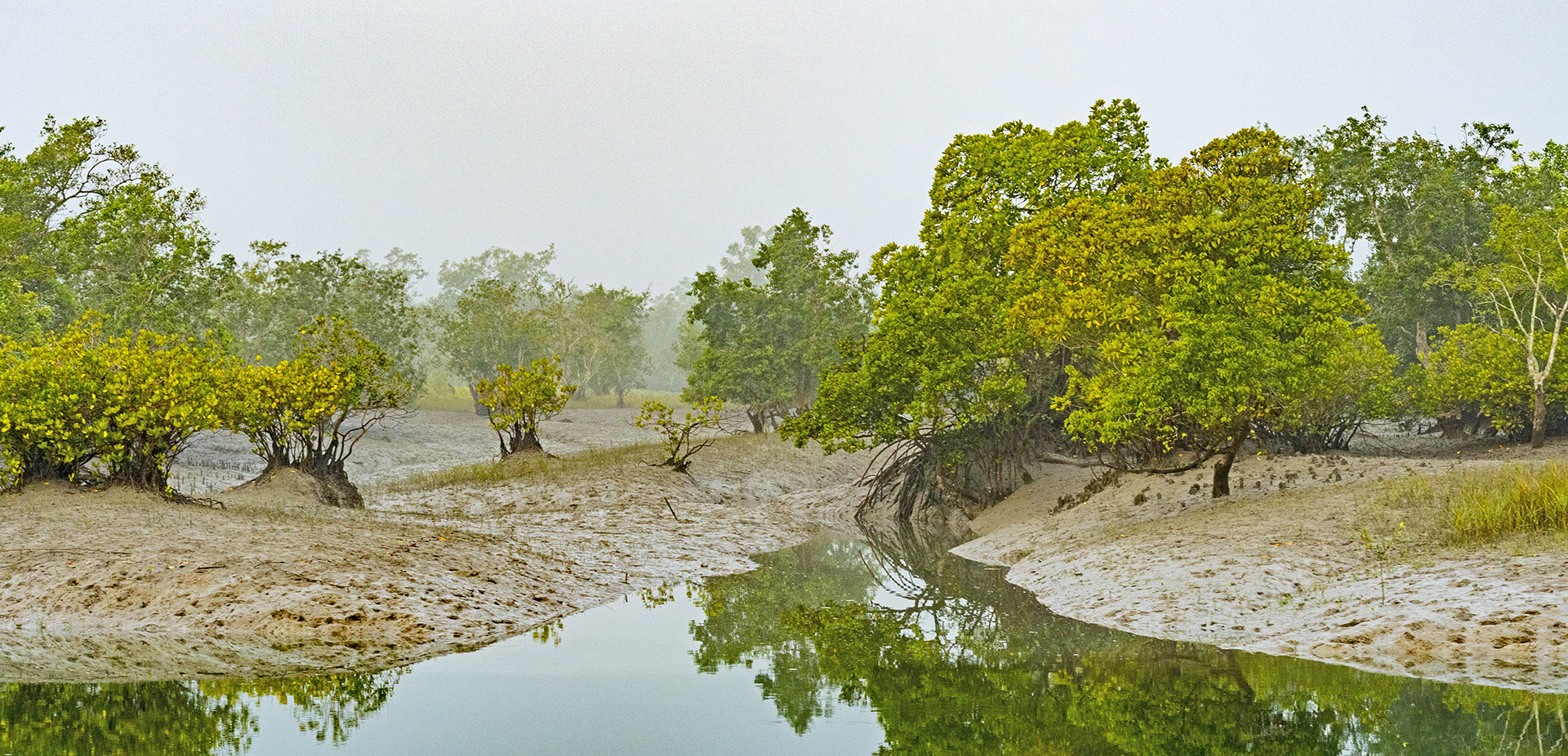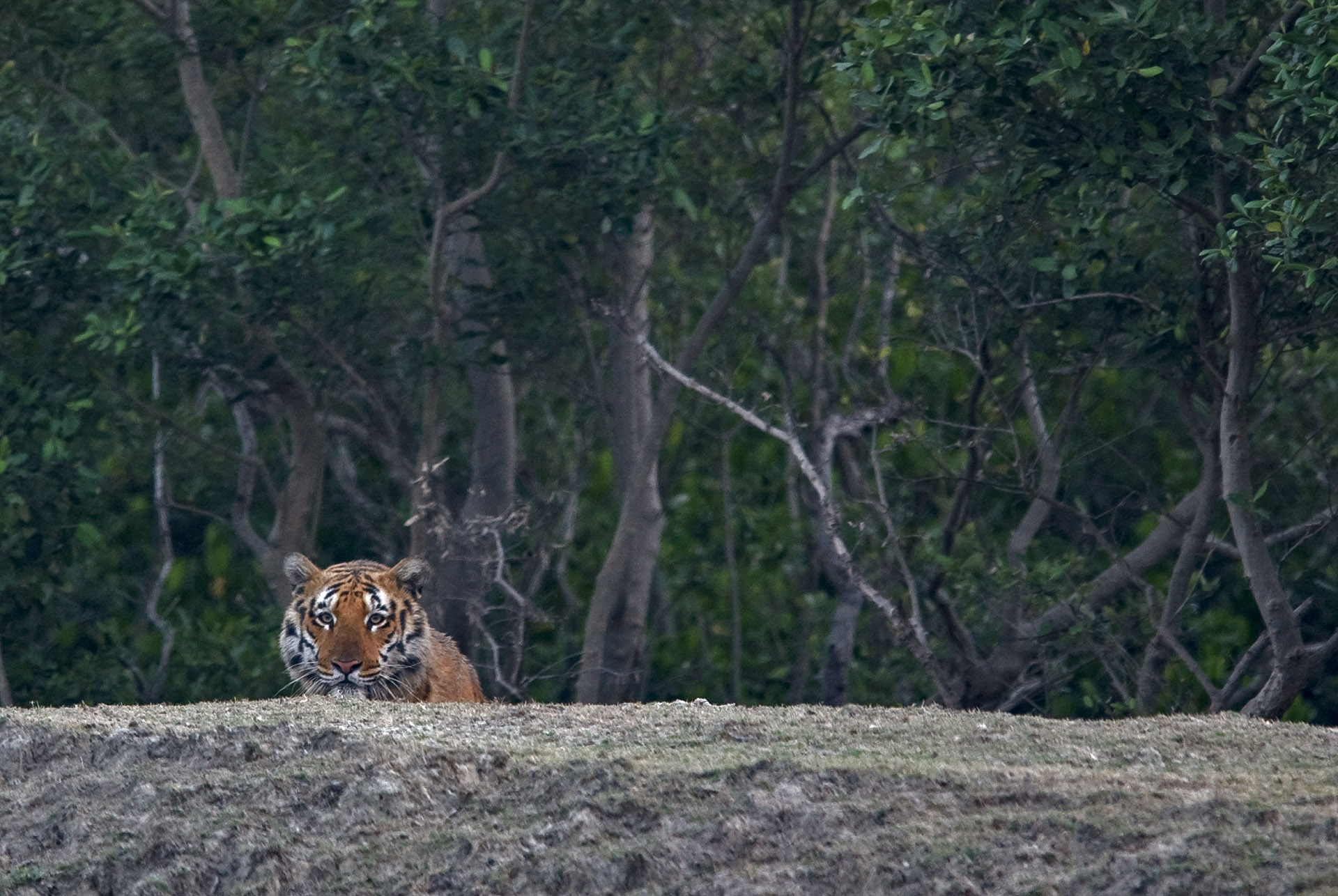On the map, the Sundarbans looks like a network of determined blue rivers, cutting through land and marching towards the Bay of Bengal. But once you are in the heart of it, it is hard to tell where it begins or ends.
At dawn, our boat sluggishly drifts through the soft, morning mist along endless creeks and canals. In the summers and monsoons, the currents rage as tidal waves crash on the coast and whirlpools swirl where tributaries meet. But on chilly December mornings like these, the meandering waters are in no hurry. Nothing moves. I hear little except the steady rumble of my boat’s engine that threatens to lull me to sleep. But the tales Ramkrishna Mondal, my forest guide, tells me — of cyclones, goddesses, crocodiles and man-eating tigers — keep me wide awake. He starts off with a story of an island we first saw when we entered the Sundarbans. “That was Gosaba. GO-SA-BA,” he says, slowly enunciating every syllable. “‘Go’ stands for gosaap, Bengali for the water monitor lizard that swaggers along our banks. ‘Sa’ for saap or snakes, that slither through the dense foliage, and ‘Ba’ for bagh, or the Bengal tiger that has the Sundarbans under its spell,” he says. I look around. A harmless curlew, a brown shorebird, sticks its exceptionally long, curved bill into the soft sand and pulls out a worm. If Mondal hadn’t pointed at the broken mangrove branches ravaged by Bulbul, a cyclone that hit the islands in November 2019 affecting the lives of over 30 lakh people, I wouldn’t have noticed. My peaceful view belies the wild and violent history of this forest. Today, ours is the only boat in this endless landscape. I settle on the tip of the wooden deck, and feel like I have its vast waters all to myself.

When the tide is high, large tracts of the forest disappear underwater, but when the tide recedes the forest takes form. Vast rivers turn into tiny streams that twist along sandy islands, exposing a rich ecosystem. Cover: Mangroves in the riverine forests of the Sundarbans have incredible root adaptations. Aerial roots stick out of the mud like snorkels, helping an underground network of roots breathe and enabling them to survive in harsh habitats.
Aqua montage
The fine riverine mosaic of the Sundarbans is born out of the confluence of three gargantuan rivers — the Ganga and the Brahmaputra, originating in the glacial Himalayas, meet and merge in India, while the Meghna forms and flows across the border in Bangladesh. Before they spill into the Bay of Bengal they split into hundreds of tributaries, depositing sediments along the way to form an archipelago of fertile islands. As they get closer to the sea, fresh water coursing from the Himalayas meets the saline waters streaming up with the tide from the Bay of Bengal. The confluence gives birth to a vast salt-tolerant, tide-dominated mangrove forest that stretches across the coast of West Bengal and Bangladesh. Forty per cent or 102 of these islands lie within Indian borders. Over the last two centuries, 54 of these have been claimed by humans. Over four million people live in this challenging, tidal habitat — their life, culture, food, songs, livelihoods, rooted in the same saline waters they share with the creatures around them. Few forested regions in the world exist in such close quarters to a densely populated area. The remaining 48 islands are bastions of the wild.
Time and tide
On all 102 islands, the tide dominates. Robi, my boatman, has learnt to tell time by looking at the waters. One morning I absentmindedly ask him what day it is. “It is Wednesday, but also Ashtami. Four more days to Purnima or full moon, when the tide is the highest,” he says, wisely. Twice a day, the tide in the Sundarbans ebbs and flows. When the tide is high, it swallows large parts of the mangrove forest, and the islands look like turtles floating in water. Everything is suspiciously still and quiet. But as the tide recedes, the forest reveals itself in all its glory. Wet shores glisten in the sharp sun. Their sands are studded with crustaceans, white screw shells, a species of sea snail, and excited mudskippers, amphibious fish that hop out of water and etch patterns on the sand. “The Sundarbans is a strange place,” says Mondal, “Here tigers swim and fish walk on land,” he laughs. Water monitor lizards swagger along its banks, flicking their long, forked tongues. Estuarine crocodiles step out to soak up some sun.
A horizontal salt-line divides the landscape, marking where the tide had risen a few hours ago. The mangroves closer to the waters, caked in dry salt crystals, shine like a silver forest, while the untouched top half is a bright, emerald green. This forest overwhelms and enchants me like no other.
The Sundarbans has many names, Mondal says. In the local language Bengali, it literally means a “beautiful forest,” but many say it is also named after the Sundari tree, a mangrove species that once populated the landscape, but is now threatened because of the increasing salinity of the waters that it struggles to survive in. The British called it Sunderbunds where “bunds” stood for the mud walls the locals built on the inhabited island’s edges to keep the tide from flooding their village.
Thriving ecosystem
The forests are tallest at the heart of the forested islands, but from our boat we can see barely a few feet into them. Occasionally we see a wild boar or a spotted deer gingerly walk to the edge for a quick dip in the water. And then, finally, we see our first set of tiger pugmarks etched deep into the moist clay. “You may never see the tiger, but in the Sundarbans it always makes its presence felt,” says Mondal.
A large number of species thrive in the mangrove forests along these shifting tidal waters. The Indian Sundarbans boasts of over 50 species of reptiles, 200 species of birds, and at least 30 species of mammals, including endangered Gangetic dolphins, estuarine crocodiles, olive Ridley turtles, water monitor lizards, otters, leopard cat, fishing cat, spotted deer, rhesus macaques and Bengal tigers. Compared to their counterparts living in far more agreeable landscapes, the species here are hardy survivors and have developed extraordinary abilities to face regular storms, daily tides, and frequent floods. For instance, almost all terrestrial mammals of the Sundarbans are excellent swimmers.
Records show that about a hundred years ago, before the Sundarbans was split along political borders and its islands colonised, the landscape supported a far richer unparalleled biodiversity. Evidence of it emerges every once in a while. In the early 2000s, in Mollakhali village of the Sundarbans, while digging for a pond, the locals found abnormally large pieces of skulls, ribs, and legs. When tested scientists at the Zoological Survey of India confirmed that they belonged to the critically endangered Javan rhino. Today, only about 60 individuals survive in Indonesia.
Divine tales
Through the day, I spend long hours peering into the forest for the tiger. But along the shore, the mudskipper and the lesser adjutants marching in stiff gait are my most steady companions. At lunch, over heaps of rice, steaming fish curry, and hot crispy aloo bhajaa, or batter-fried potato, Mondal and Robi tell me tales of their childhood. I learn that the Sundarbans is abundant and generous, but it takes away as much as it gives. It has two starkly different faces. For a tourist that cruises through its wide channels on a secure motorboat, the Sundarbans is an endless oasis of calm and peace. But for local fishermen who must deflect from the wide channels, into adjacent narrow creeks in tiny, hand-rowed dinghies and get off into waist-deep quicksand-like muck while fishing for crab, death lurks in water and on land. “Danga-e bagh, jol-e kumir,” says Robi. “Tiger on land, crocodile in water. That is the Sundarbans.” A child in the Sundarbans grows up learning to live with persistent storms and cyclones (Mondal, who is 43, can count as many as 15 cyclones in his lifetime), and the looming fear of the tiger. “We all know somebody who went to the forest to fish and was taken by the tiger,” he says. Official figures say that in 2019, the tiger killed 15 fishermen and honey collectors who had ventured into the forest. Mondal tells me the number is probably closer to a hundred.
I also learn that the Sundarbans is as much a forest as it is a network of myths and ghosts, where the divine and wild intertwine. Every channel has its own distinct name, and often a temple of the forest guardian spirits. Every predator has its own deity. “You pray to Ma Manasha if you want to save yourself from snakes. You pray to Kalu Rai, if you don’t want the crocodile to come after you. And you pray to Bonbibi, the greatest, if you want to keep the tiger away,’ says Robi. And as if on cue, Mondal tells me my favourite story of the trip so far:
Once upon a time, every evening, at sunset, Dakshin Rai, an evil zamindar, transformed into a tiger and preyed on the hapless people of the Sundarbans. After years of prayers, Allah decided to send Bonbibi, the daughter of a Sufi fakir, to vanquish the zamindar. However, instead of killing Dakshin Rai, the magnanimous and forgiving Bonbibi struck a deal — she would spare anyone who worships her.

Nypa fruticans or golpata is a mangrove palm that is abundantly found in the forests of the Sundarbans. Locals use its leaves to thatch the roofs of their mud homes.
Bonbibi’s gift
Soon after hearing this story, our boat docks at the Sundhanyakhali watchtower that overlooks a freshwater pond. The watchtower is a popular destination from which to spot a tiger. At the entrance I see a small, humble Bonbibi temple, with idols made of plaster of Paris, coloured in garish bright, chipping paint. In these divisive times, a temple of a Sufi goddess, manned by a Hindu priest, inspires both wonder and hope. In the Sundarbans, both Hindus and Muslims worship Bonbibi.

The Bengal tiger is the Sundarban’s apex predator. The mangrove forests are one of the largest remaining continuous habitats of the tiger in the world. A little over 100 tigers survive in the Indian part of the Sundarbans.
As I gaze at the temple, we hear somebody scream, “Bagh!” We scurry to the top of the watchtower. I see a spotted deer run across the landscape with her fawn, screaming in alarm. The rhesus macaques on the trees create a racket. Minutes later a sure-footed tigress saunters into view. By now a large crowd has gathered on the watchtower, whispering, shoving each other. Amidst the chaos the tigress calmly walks to the bank, crouches, lowers her neck, and with her eyes trained on us, takes a sip. Her silky, dark-and-deep-gold coat gathers around her shoulder blades. Her tail, alert and erect, sticks up in the air. After at least 15 minutes, the tigress walks away, and the crowd erupts in cheers. “Sundarbans is successful!” screams an enthusiastic tourist. Some women, overcome with emotion, rush to the temple entrance to thank Bonbibi. A part of the crowd on the watchtower has shifted to the temple now. “Earlier fishermen prayed so they wouldn’t see the tiger. Then poachers prayed so they could kill the tiger. Now tourists pray so they can see the tiger,” laughs Mondal. “Bonbibi listens to everyone.”
In the Sundarbans, there’s magic, and myth at every bend.

